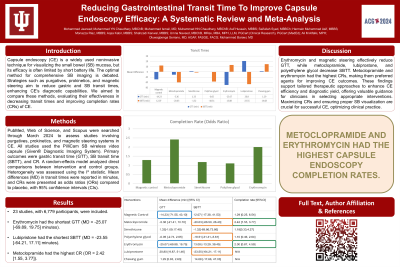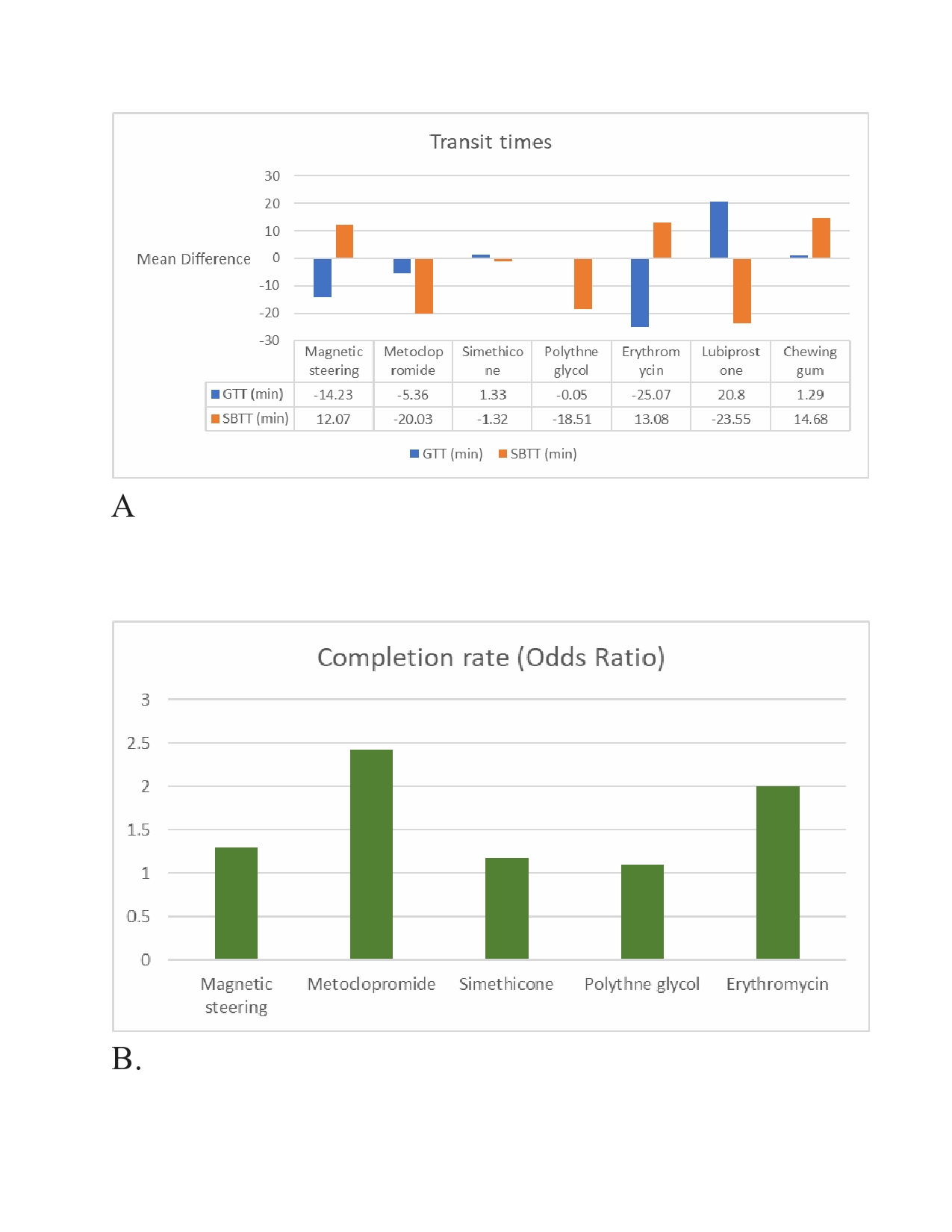Sunday Poster Session
Category: General Endoscopy
P0675 - Reducing Gastrointestinal Transit Time To Improve Capsule Endoscopy Efficacy: A Systematic Review and Meta-Analysis
Sunday, October 27, 2024
3:30 PM - 7:00 PM ET
Location: Exhibit Hall E

Has Audio
Presenting Author(s)
Mohammad Jawwad, MBBS1, Muhammad YN. Chaudhary, MBChB2, Muhammad Ismail, MD3, Muhammad H N. Chaudhary, MBChB4, Asif Hussain, MBBS5, Saifullah Syed, MBBCh6, Harmain Muhammad. Asif, MBBS7, Monazza Riaz, MBBS8, Aqsa Kabir, MBBS1, Shahzadi Kanwal, MBBS9, Umna Naveed, MBChB, MBA, MPH10, Ali M. Alfalki, MPH11, Oluwagbenga Serrano, MD, FACG12, Mohammed Barawi, MD13
1Dow Medical College, Karachi, Sindh, Pakistan; 2Indiana University Southwest, Evansville, IN; 3Indiana University Southwest, Cedar Rapids, IA; 4Manchester University NHS Foundation Trust, Stockport, England, United Kingdom; 5Liaquat University of Medical and Health Science, Hyderabad, Sindh, Pakistan; 6Royal College of Surgeons, Dublin, Dublin, Ireland; 7Shaheed Mohtarma Benazir Bhutto Medical College, Karachi, Sindh, Pakistan; 8Dow Medical College, Norwich, England, United Kingdom; 9Karachi Medical and dental college, Karachi, Sindh, Pakistan; 10NHS, Liverpool, England, United Kingdom; 11University of South Carolina, Columbia, SC; 12Good Samaritan Hospital, Vincennes, IN; 13Ascension St. John Hospital, Detroit, MI
Introduction: Capsule endoscopy (CE) is a widely used noninvasive technique for visualizing the small bowel (SB) mucosa, but its efficacy is often limited by short battery life. The optimal method for comprehensive SB imaging is debated. Strategies such as purgatives, prokinetics, and magnetic control (MC) aim to reduce gastric and SB transit times, enhancing CE's diagnostic capabilities. This systematic review and meta-analysis compare these methods, evaluating their effectiveness in decreasing transit times and improving completion rates (CRs) of CE.
Methods: A comprehensive literature search was conducted using PubMed, Web of Science, and Scopus, focusing on studies involving purgatives, prokinetics, and MC systems in CE. All studies used the PilliCam SB wireless video capsule (Given® Diagnostic Imaging System). Primary outcomes were gastric transit time (GTT), SB transit time (SBTT), and CR. A random-effects model analyzed direct comparisons between intervention and control groups. Heterogeneity was assessed using the I² statistic. Mean differences (MD) in transit times were reported in minutes, and CRs were presented as odds ratios (ORs) compared to placebo, with 95% confidence intervals.
Results: The meta-analysis included 23 studies comprising 6,779 participants. The magnetic steering group (MSG) had higher odds of completing the SB examination compared to the control group (OR = 1.29 [0.25, 6.54]). The MSG showed a shorter GTT (MD = -14.23 [-71.55, 43.10] min) but a longer SBTT (MD = 12.07 [-17.38, 41.53] min). The lubiprostone group had a longer GTT (MD = 20.80 [-9.87, 51.46] min) and a shorter SBTT (MD = -23.55 [-64.21, 17.11] min) compared to the control group. The metoclopramide group had the highest odds of completing the CE (OR = 2.42 [1.55, 3.77]).Chewing gum and erythromycin showed an increase in SBTT, while the polyethylene glycol group featured a decrease in SBTT. Simethicone did not significantly alter either transit time.(Table 1)
Discussion: The results show erythromycin and MC effectively reduce GTT, while metoclopramide, lubiprostone, and polyethylene glycol decrease SBTT. Metoclopramide and erythromycin also had higher CRs, making them potential preferred agents for improving CE outcomes. These findings support tailored therapeutic approaches to enhance CE efficiency and diagnostic yield, offering valuable guidance for clinicians in selecting appropriate interventions. Maximizing CRs and ensuring proper SB visualization are crucial for successful CE, optimizing clinical practice

Note: The table for this abstract can be viewed in the ePoster Gallery section of the ACG 2024 ePoster Site or in The American Journal of Gastroenterology's abstract supplement issue, both of which will be available starting October 27, 2024.
Disclosures:
Mohammad Jawwad, MBBS1, Muhammad YN. Chaudhary, MBChB2, Muhammad Ismail, MD3, Muhammad H N. Chaudhary, MBChB4, Asif Hussain, MBBS5, Saifullah Syed, MBBCh6, Harmain Muhammad. Asif, MBBS7, Monazza Riaz, MBBS8, Aqsa Kabir, MBBS1, Shahzadi Kanwal, MBBS9, Umna Naveed, MBChB, MBA, MPH10, Ali M. Alfalki, MPH11, Oluwagbenga Serrano, MD, FACG12, Mohammed Barawi, MD13. P0675 - Reducing Gastrointestinal Transit Time To Improve Capsule Endoscopy Efficacy: A Systematic Review and Meta-Analysis, ACG 2024 Annual Scientific Meeting Abstracts. Philadelphia, PA: American College of Gastroenterology.
1Dow Medical College, Karachi, Sindh, Pakistan; 2Indiana University Southwest, Evansville, IN; 3Indiana University Southwest, Cedar Rapids, IA; 4Manchester University NHS Foundation Trust, Stockport, England, United Kingdom; 5Liaquat University of Medical and Health Science, Hyderabad, Sindh, Pakistan; 6Royal College of Surgeons, Dublin, Dublin, Ireland; 7Shaheed Mohtarma Benazir Bhutto Medical College, Karachi, Sindh, Pakistan; 8Dow Medical College, Norwich, England, United Kingdom; 9Karachi Medical and dental college, Karachi, Sindh, Pakistan; 10NHS, Liverpool, England, United Kingdom; 11University of South Carolina, Columbia, SC; 12Good Samaritan Hospital, Vincennes, IN; 13Ascension St. John Hospital, Detroit, MI
Introduction: Capsule endoscopy (CE) is a widely used noninvasive technique for visualizing the small bowel (SB) mucosa, but its efficacy is often limited by short battery life. The optimal method for comprehensive SB imaging is debated. Strategies such as purgatives, prokinetics, and magnetic control (MC) aim to reduce gastric and SB transit times, enhancing CE's diagnostic capabilities. This systematic review and meta-analysis compare these methods, evaluating their effectiveness in decreasing transit times and improving completion rates (CRs) of CE.
Methods: A comprehensive literature search was conducted using PubMed, Web of Science, and Scopus, focusing on studies involving purgatives, prokinetics, and MC systems in CE. All studies used the PilliCam SB wireless video capsule (Given® Diagnostic Imaging System). Primary outcomes were gastric transit time (GTT), SB transit time (SBTT), and CR. A random-effects model analyzed direct comparisons between intervention and control groups. Heterogeneity was assessed using the I² statistic. Mean differences (MD) in transit times were reported in minutes, and CRs were presented as odds ratios (ORs) compared to placebo, with 95% confidence intervals.
Results: The meta-analysis included 23 studies comprising 6,779 participants. The magnetic steering group (MSG) had higher odds of completing the SB examination compared to the control group (OR = 1.29 [0.25, 6.54]). The MSG showed a shorter GTT (MD = -14.23 [-71.55, 43.10] min) but a longer SBTT (MD = 12.07 [-17.38, 41.53] min). The lubiprostone group had a longer GTT (MD = 20.80 [-9.87, 51.46] min) and a shorter SBTT (MD = -23.55 [-64.21, 17.11] min) compared to the control group. The metoclopramide group had the highest odds of completing the CE (OR = 2.42 [1.55, 3.77]).Chewing gum and erythromycin showed an increase in SBTT, while the polyethylene glycol group featured a decrease in SBTT. Simethicone did not significantly alter either transit time.(Table 1)
Discussion: The results show erythromycin and MC effectively reduce GTT, while metoclopramide, lubiprostone, and polyethylene glycol decrease SBTT. Metoclopramide and erythromycin also had higher CRs, making them potential preferred agents for improving CE outcomes. These findings support tailored therapeutic approaches to enhance CE efficiency and diagnostic yield, offering valuable guidance for clinicians in selecting appropriate interventions. Maximizing CRs and ensuring proper SB visualization are crucial for successful CE, optimizing clinical practice

Figure: Figure 1. (A) Mean differences in Gastric transit times (GTT) amd Small Bowel Transit times (SBTT) in each intervention groups. (B) Completion rate in each intervention group.
Note: The table for this abstract can be viewed in the ePoster Gallery section of the ACG 2024 ePoster Site or in The American Journal of Gastroenterology's abstract supplement issue, both of which will be available starting October 27, 2024.
Disclosures:
Mohammad Jawwad indicated no relevant financial relationships.
Muhammad Chaudhary indicated no relevant financial relationships.
Muhammad Ismail indicated no relevant financial relationships.
Muhammad Chaudhary indicated no relevant financial relationships.
Asif Hussain indicated no relevant financial relationships.
Saifullah Syed indicated no relevant financial relationships.
Harmain Asif indicated no relevant financial relationships.
Monazza Riaz indicated no relevant financial relationships.
Aqsa Kabir indicated no relevant financial relationships.
Shahzadi Kanwal indicated no relevant financial relationships.
Umna Naveed indicated no relevant financial relationships.
Ali Alfalki indicated no relevant financial relationships.
Oluwagbenga Serrano: MERCK – Stock-publicly held company(excluding mutual/index funds).
Mohammed Barawi: Abbvie – Speakers Bureau. Boston scietific – Consultant. Gilead – Speakers Bureau. Olympus – Consultant.
Mohammad Jawwad, MBBS1, Muhammad YN. Chaudhary, MBChB2, Muhammad Ismail, MD3, Muhammad H N. Chaudhary, MBChB4, Asif Hussain, MBBS5, Saifullah Syed, MBBCh6, Harmain Muhammad. Asif, MBBS7, Monazza Riaz, MBBS8, Aqsa Kabir, MBBS1, Shahzadi Kanwal, MBBS9, Umna Naveed, MBChB, MBA, MPH10, Ali M. Alfalki, MPH11, Oluwagbenga Serrano, MD, FACG12, Mohammed Barawi, MD13. P0675 - Reducing Gastrointestinal Transit Time To Improve Capsule Endoscopy Efficacy: A Systematic Review and Meta-Analysis, ACG 2024 Annual Scientific Meeting Abstracts. Philadelphia, PA: American College of Gastroenterology.


.jpeg.jpg)